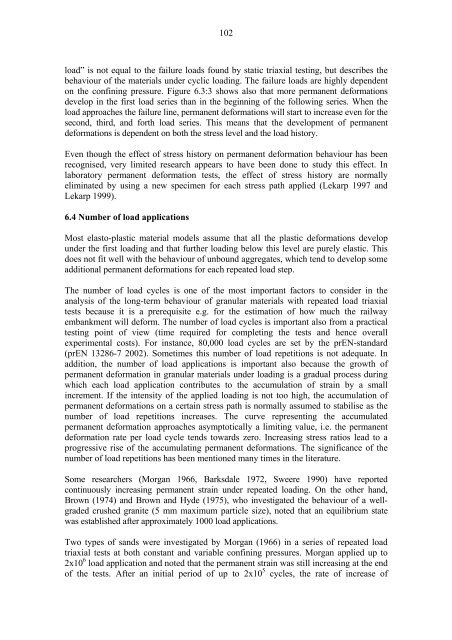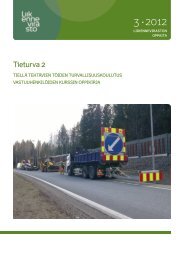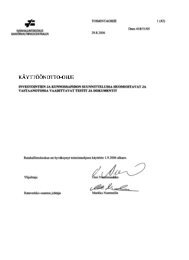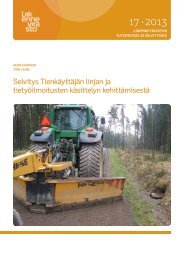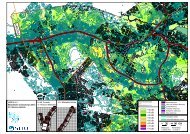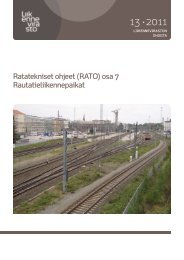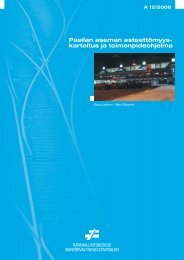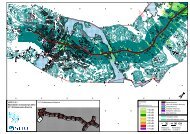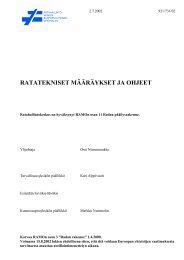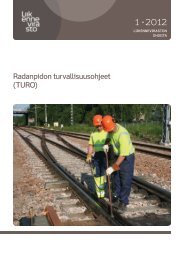Deformation behaviour of railway embankment ... - Liikennevirasto
Deformation behaviour of railway embankment ... - Liikennevirasto
Deformation behaviour of railway embankment ... - Liikennevirasto
You also want an ePaper? Increase the reach of your titles
YUMPU automatically turns print PDFs into web optimized ePapers that Google loves.
102<br />
load” is not equal to the failure loads found by static triaxial testing, but describes the<br />
<strong>behaviour</strong> <strong>of</strong> the materials under cyclic loading. The failure loads are highly dependent<br />
on the confining pressure. Figure 6.3:3 shows also that more permanent deformations<br />
develop in the first load series than in the beginning <strong>of</strong> the following series. When the<br />
load approaches the failure line, permanent deformations will start to increase even for the<br />
second, third, and forth load series. This means that the development <strong>of</strong> permanent<br />
deformations is dependent on both the stress level and the load history.<br />
Even though the effect <strong>of</strong> stress history on permanent deformation <strong>behaviour</strong> has been<br />
recognised, very limited research appears to have been done to study this effect. In<br />
laboratory permanent deformation tests, the effect <strong>of</strong> stress history are normally<br />
eliminated by using a new specimen for each stress path applied (Lekarp 1997 and<br />
Lekarp 1999).<br />
6.4 Number <strong>of</strong> load applications<br />
Most elasto-plastic material models assume that all the plastic deformations develop<br />
under the first loading and that further loading below this level are purely elastic. This<br />
does not fit well with the <strong>behaviour</strong> <strong>of</strong> unbound aggregates, which tend to develop some<br />
additional permanent deformations for each repeated load step.<br />
The number <strong>of</strong> load cycles is one <strong>of</strong> the most important factors to consider in the<br />
analysis <strong>of</strong> the long-term <strong>behaviour</strong> <strong>of</strong> granular materials with repeated load triaxial<br />
tests because it is a prerequisite e.g. for the estimation <strong>of</strong> how much the <strong>railway</strong><br />
<strong>embankment</strong> will deform. The number <strong>of</strong> load cycles is important also from a practical<br />
testing point <strong>of</strong> view (time required for completing the tests and hence overall<br />
experimental costs). For instance, 80,000 load cycles are set by the prEN-standard<br />
(prEN 13286-7 2002). Sometimes this number <strong>of</strong> load repetitions is not adequate. In<br />
addition, the number <strong>of</strong> load applications is important also because the growth <strong>of</strong><br />
permanent deformation in granular materials under loading is a gradual process during<br />
which each load application contributes to the accumulation <strong>of</strong> strain by a small<br />
increment. If the intensity <strong>of</strong> the applied loading is not too high, the accumulation <strong>of</strong><br />
permanent deformations on a certain stress path is normally assumed to stabilise as the<br />
number <strong>of</strong> load repetitions increases. The curve representing the accumulated<br />
permanent deformation approaches asymptotically a limiting value, i.e. the permanent<br />
deformation rate per load cycle tends towards zero. Increasing stress ratios lead to a<br />
progressive rise <strong>of</strong> the accumulating permanent deformations. The significance <strong>of</strong> the<br />
number <strong>of</strong> load repetitions has been mentioned many times in the literature.<br />
Some researchers (Morgan 1966, Barksdale 1972, Sweere 1990) have reported<br />
continuously increasing permanent strain under repeated loading. On the other hand,<br />
Brown (1974) and Brown and Hyde (1975), who investigated the <strong>behaviour</strong> <strong>of</strong> a wellgraded<br />
crushed granite (5 mm maximum particle size), noted that an equilibrium state<br />
was established after approximately 1000 load applications.<br />
Two types <strong>of</strong> sands were investigated by Morgan (1966) in a series <strong>of</strong> repeated load<br />
triaxial tests at both constant and variable confining pressures. Morgan applied up to<br />
2x10 6 load application and noted that the permanent strain was still increasing at the end<br />
<strong>of</strong> the tests. After an initial period <strong>of</strong> up to 2x10 5 cycles, the rate <strong>of</strong> increase <strong>of</strong>


